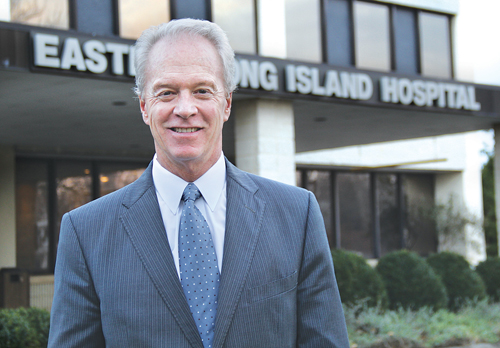Report: ELIH only hospital in Suffolk to earn an ‘A’ in patient safety

Eastern Long Island Hospital in Greenport earned the highest grade in Suffolk County for patient safety, according to a recently released report from The Leapfrog Group, a national nonprofit that aims to improve the quality and safety of American health care.
ELIH received an “A” and was one of 823 hospitals nationwide to receive the highest grade. The grades are determined by sorting through 30 measures using publicly available hospital safety data and are calculated by patient safety experts and peer-reviewed, according to an ELIH press release. Grades are awarded twice a year. In 2016, ELIH received a B for both spring and fall.
Not all 30 measures were used in ELIH’s calculation. Data for some specific measures like “infection in the blood during ICU stay,” was not available because there were too few cases to report data, a hospital spokeswoman said. Nine measures were listed under “declined to report” because Leapfrog could not pull that information from the state-mandated data ELIH is required to submit, the spokeswoman added.
Improving patient safety became a greater focal point for hospitals after the 100,000 Lives Campaign was launched by the Institute for Healthcare Improvement more than a decade ago. The goal was to bring hospitals together in a commitment to make changes to avoid preventable deaths and save 100,000 lives in the first 18-year period and then every year following.
The Suffolk Times talked with ELIH chief executive officer Paul Connor and Tara Kraemer, who is responsible for the hospital’s quality program, about patient safety practices.
The Suffolk Times: What steps have been taken to improve patient safety in recent years?
Tara Kraemer: We’ve been working on a program for antibiotic stewardship to ensure that when we do treat our patients we make sure we have the information necessary to do that and we provide patients with appropriate antibiotics. We continually review to ensure there’s no adverse outcomes related to that … Another area is infection prevention. One of the other programs we’ve been working on is taking a look at the care we provide for specific disease entities or processes. One of them is sepsis … Another infection prevention program that we’re working on is hand hygiene and that’s basically ensuring that we properly cleanse our hands before and after going into patients’ rooms and use gloves when appropriate, taking them off when appropriate.
Paul Connor: You can see our quality program is a highly integrated program that looks to see how processes work within the hospital to make sure the patients are getting the outcome that we expect them to get. When we have a problem with it, we have a committee that basically looks carefully at what happened to the situation … It’s sort of a standard to look at making sure that everything that gets to the patient is safe and works as we expect it to work.
ST: What does it mean to you to receive this grade?
PC: Of course, it’s basically a validation of the systems that we have in place and the processes we have in place to ensure we have a safe environment for our patients. I think also, it’s really gratifying for me as the CEO to give credit to the caregivers who really deserve this A. I think it’s nice to get an A, but it’s really nice to get good outcomes where you don’t have any hospital-acquired conditions or you have very, very, very few. That really is the most gratifying, where the patient gets discharged in a safe manner and gets to go home feeling better than they came in.
ST: What is the hospital graded on and how does one receive an A?
TK: When Leapfrog attempts to provide grades to facilities they take a look at process measures, structural measures and outcome measures. So process measures would be how well we provide care. An example of that would be when they look at how responsive hospital staff is to patients … we do fairly well with that, we received four stars in that measure out of five.
PC: Much of this data from Leapfrog is acquired through different sources — Medicare, Agency for Healthcare Research and Quality, Centers for Disease Control and other agencies. All of this is basically publicly reported information that hospitals report as part of how we interface with the regulators.
ST: Why is patient safety so important?
PC: Most of us don’t know a lot about what happens in a hospital and what happens to the patient when they’re cared for … So we put our trust into people in hospitals and we know that and the hospitals want to earn your trust. Showing that we got an A in patient safety is a way to demonstrate that.
ST: What prior grades has the hospital received?
PC: We’ve received every letter but an F. We started climbing up the hill with a D, and then we got a C, and then we got a B, and then we got an A. We just don’t want to start going back down the hill … We’re a small hospital, so for us to get an A with this, given our numbers are so small, to me is remarkable.
Correction: An earlier version misspelled Tara Kraemer’s name.
File photo: ELIH CEO Paul Connor. (Credit: Carrie Miller)









